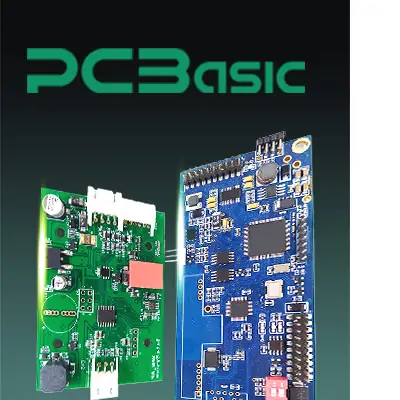

Global high-mix volume high-speed PCBA manufacturer
9:00 -18:00, Mon. - Fri. (GMT+8)
9:00 -12:00, Sat. (GMT+8)
(Except Chinese public holidays)


Global high-mix volume high-speed PCBA manufacturer
9:00 -18:00, Mon. - Fri. (GMT+8)
9:00 -12:00, Sat. (GMT+8)
(Except Chinese public holidays)
HomePage > Blog > Knowledge Base > Why Choose Blue Circuit Boards? |The Difference Between Blue and Green Circuit Boards
When it comes to electronic devices, PCBs act as a backbone of their functionality. These PCBs can be found in smartphones and game consoles as the operational devices within the electronics. There has been a leading dominating use of green circuit boards until a while ago when blue circuit boards started taking over the market. This change isn't just about color aesthetics, preference, or brand differentiation; it is about the value, functionalities, and better visibility the blue circuit board provides.
These differences may sound vague to you at first, and you may ask why there is a need for a blue circuit board instead of a green circuit board. This article covers the most critical factors, making a case for blue PCBs in improving your product. We will count the unique characteristics of the two PCB colors and their various application fields. For example, blue boards are primarily seen in modern electronics, high-end products like wearables, and modern gaming consoles, where visibility and polish are necessary.

Aesthetic appeal is not the only benefit of blue boards, as they also offer other advantages. Some other factors have led to their increased preference by engineers and designers.
An argument in favor of the choice of blue circuit boards is that blue solder masks and copper traces have a contrast, which serves as an advantage when it comes to visibility. The blue circuit board background helps engineers detect faults and errors during the manufacturing and testing phases. Be it examining joints, checking for solder quality, or troubleshooting.
Blue PCBs are also appreciated for their longevity. It's known that the blue solder mask is moisture and chemical-resistant, making it a clear winner in the blue vs green circuit board war. This helps eliminate issues like cracks or peels that are associated with other cases.
 About PCBasic
About PCBasic
Time is money in your projects – and PCBasic gets it. PCBasic is a PCB assembly company that delivers fast, flawless results every time. Our comprehensive PCB assembly services include expert engineering support at every step, ensuring top quality in every board. As a leading PCB assembly manufacturer, we provide a one-stop solution that streamlines your supply chain. Partner with our advanced PCB prototype factory for quick turnarounds and superior results you can trust.

Blue circuit boards are rarely seen, and due to this, they are more costly. While green circuit boards, as the norm of the general industry, are cheaper and can be obtained from any supplier.
The blue board allows for a thorough inspection. The difference in the blue solder mask and the copper traces is too obvious that not only engineers or technicians but even a normal person can differentiate between them, making it easier to detect faults and hence helps in repairability. Green PCBs still retain visibility, but the contrast is slightly less than that of blue, making this PCB color a less viable choice for easy fault and error detection.
Blue PCBs in most cases provide on-par thermal management with green circuit boards, commonly used in high technology like gaming consoles and industrial systems for accurate levels of thermal management. In general-purpose applications, green PCBs are made in such a way as to allow for reasonable thermal management. It is common in electronic devices and other household appliances where only essential heating and cooling is required.
Blue circuit boards are more resistant to damage, especially for electronic circuits working under moisture and chemicals. While green PCBs also have durable, moisture-proof structures. Reliable under most conditions, these boards can be used in varying environments but may not perform as well as blue boards under some extreme conditions.
High-frequency design is another area where blue PCBs might be preferred because of their improved signal integrity. High signal integrity reduces the impact of noise and eliminates distortion within advanced communication systems and other high-performance systems.

In the early years of electronics, we noticed that the advantages of green circuit boards come mostly from using green epoxy resin for the solder mask. This color may not have been chosen for any specific technical consideration, but it became common as the final standard PCB color.
With progress and the expansion of electronics manufacturing factories, the need for more custom designs and looks also increased. The competition in this industry began to intensify as companies entered into the production of PCBs with different colored solder masks. That is when blue circuit boards came in.
Blue PCBs were not only produced to break free from the traditional green color but also to meet modern industry standards, where good visibility during testing phases was needed.
Amidst the dominance of the green circuit board market, blue circuit boards provide the means for brands to differentiate themselves. This kind of differentiation is not simply in the PCB color but in communicating a sense of innovation, a level of care, and high quality.
In the case of clients selling individual projects or limited collections, a blue PCB may serve as an element of the brand image, which is more appealing to consumers looking for distinguishing features in the products.
The use of blue PCBs became popular in modern electronics partly due to their contrast to copper traces. The Blue circuit boards are beneficial in assembly and maintenance, where circuits need to be visible for repair purposes. The blue circuit board background is significant when it comes to assembly and maintenance since circuits need to be highly visible for troubleshooting.
Aside from the positives of these blue PCBs, they also have a trendy appearance. There are plenty of companies that utilize blue circuit boards in devices, as the design further bulks up the user experience. Using a blue PCB can give products a polished and premium look that differentiates them from the typical green boards seen in most devices.
Because of its premium look and functionality, blue PCBs are usually for specialty and high-end products. In areas where the aesthetic quality of the finished product is essential, such as in gaming devices or other high-end consumer electronics, blue PCBs win the war against green circuit boards.

Blue PCBs find application in compact smartwatches, fitness bands, and other wearable accessories where miniaturization and attractive circuit design are a must. They are in harmony with the minimalist trend of most wearables because of their pleasing appearance.
It is not uncommon for hobbyists and professionals to use blue PCBs in their electronic devices or prototyping tools simply because it's aesthetically pleasing. These blue boards are common with RC drones, robots, and DIY electronics where a distinct difference between components and copper traces is vital.
Blue PCBs are used in high-end videogame consoles and computer peripherals both as an attractive element and for better usability during assembly/repair. Blue circuit boards give these products a premium look especially in this competitive market.
Many of these consumer electronic devices include blue PCBs such as smartphones, tablets and smart home assistants where beauty designs and functionalities merging are upheld. Such blue boards are also ideal as part of the beauty of modern consumer electronics.
Limited series or prototypes usually incorporate blue PCBs, which provide room for many special design features and are also believed to be more modern than other PCB colors. Servicing high-end electronics, blue boards are the best when it comes to striking a perfect balance of high performance and aesthetic appeal.

Coloring PCBs does not just fulfill a decorative purpose and there are different colors because of the different specifications, applications and manufacturing constraints. Some of the common PCB colors are as follows.
Most of the testing boards, their prototypes and limited-edition electronics are usually red. White labels printed on a red solder mask are easily seen, making it less difficult to identify and read during assembly and debugging.
One main advantage of yellow PCBs is that the copper traces and components under the solder mask are clearly visible. This PCB color is helpful in applications like lighting systems or displays where visually monitoring the circuitry is necessary.
Many people like the idea of creating custom projects and hobbyist electronics in purple, which adds a unique touch to such boards. Purple PCBs have also been installed mostly in electronics or in-house-made systems and devices where a good look is equally important as their functioning, for example, limited edition gadgets.
These types of PCBs are mostly used where the theme is just professional to the nature of the electronic devices such as mobile phones, consoles, gaming systems, and other high-end devices. Despite this advantage, there are limitations brought about by the use of black color, such as difficulties in inspection and troubleshooting.
Blue circuit boards combine an attractive look with a number of functional features and can be used for various purposes. Green PCBs can easily be referred to as the most practical panoply for they are the least expensive and the most available. Do not be surprised if you find that whether it is a wearable, a game industrial console, or a unique creative project, thanks to blue PCBs, you can not only make your product stand out from the mass production but also provide easier assembly and maintenance.
1. Does the color of the circuit have any significance?
Despite the fact that the coloration of PCBs does not impact their performance directly, it can be a factor in various aspects, such as visibility, troubleshooting, and brand recognition. For instance, more design within blue PCBs helps stand out components within the inspection.
2. Why is green the most used color during circuit board manufacturing?
For a long time, green was the color that was used for PCBs, and that has been the standard for the industry thanks to green epoxy resin, which is used in the production of PCBs.
3. Are blue-colored PCBs used in systems with high-performance requirements?
Of course. Blue boards provide a great signal as well as heat conduction. Hence, they can be used in high-speed gadgets such as game consoles and other sophisticated electronics.

Assembly Enquiry
Instant Quote
Phone contact

+86-755-27218592
In addition, we've prepared a Help Center. We recommend checking it before reaching out, as your question and its answer may already be clearly explained there.
Wechat Support

In addition, we've prepared a Help Center. We recommend checking it before reaching out, as your question and its answer may already be clearly explained there.
WhatsApp Support

In addition, we've prepared a Help Center. We recommend checking it before reaching out, as your question and its answer may already be clearly explained there.
